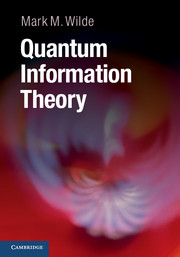Book contents
- Frontmatter
- Contents
- How To Use This Book
- Acknowledgments
- Part I Introduction
- Part II The Quantum Theory
- Part III Unit Quantum Protocols
- Part IV Tools of Quantum Shannon Theory
- 9 Distance Measures
- 10 Classical Information and Entropy
- 11 Quantum Information and Entropy
- 12 The Information of Quantum Channels
- 13 Classical Typicality
- 14 Quantum Typicality
- 15 The Packing Lemma
- 16 The Covering Lemma
- Part V Noiseless Quantum Shannon Theory
- Part VI Noisy Quantum Shannon Theory
- Appendix A Miscellaneous Mathematics
- Appendix B Monotonicity of Quantum Relative Entropy
- References
- Index
13 - Classical Typicality
from Part IV - Tools of Quantum Shannon Theory
Published online by Cambridge University Press: 05 May 2013
- Frontmatter
- Contents
- How To Use This Book
- Acknowledgments
- Part I Introduction
- Part II The Quantum Theory
- Part III Unit Quantum Protocols
- Part IV Tools of Quantum Shannon Theory
- 9 Distance Measures
- 10 Classical Information and Entropy
- 11 Quantum Information and Entropy
- 12 The Information of Quantum Channels
- 13 Classical Typicality
- 14 Quantum Typicality
- 15 The Packing Lemma
- 16 The Covering Lemma
- Part V Noiseless Quantum Shannon Theory
- Part VI Noisy Quantum Shannon Theory
- Appendix A Miscellaneous Mathematics
- Appendix B Monotonicity of Quantum Relative Entropy
- References
- Index
Summary
This chapter begins our first technical foray into the asymptotic theory of information. We start with the classical setting in an effort to build up our intuition of asymptotic behavior before delving into the asymptotic theory of quantum information.
The central concept of this chapter is the asymptotic equipartition property. The name of this property may sound somewhat technical at first, but it is merely an application of the law of large numbers to a sequence drawn independently and identically from a distribution pX(x) for some random variable X. The asymptotic equipartition property reveals that we can divide sequences into two classes when their length becomes large: those that are overwhelmingly likely to occur and those that are overwhelmingly likely not to occur. The sequences that are likely to occur are the typical sequences, and the ones that are not likely to occur are the atypical sequences. Additionally, the size of the set of typical sequences is exponentially smaller than the size of the set of all sequences whenever the random variable generating the sequences is not uniform. These properties are an example of a more general mathematical phenomenon known as “measure concentration,” in which a smooth function over a high-dimensional space or over a large number of random variables tends to concentrate around a constant value with high probability.
- Type
- Chapter
- Information
- Quantum Information Theory , pp. 327 - 363Publisher: Cambridge University PressPrint publication year: 2013

